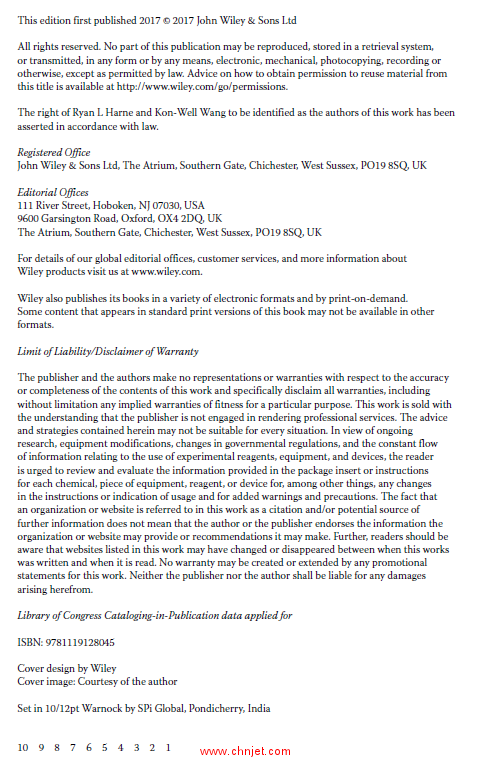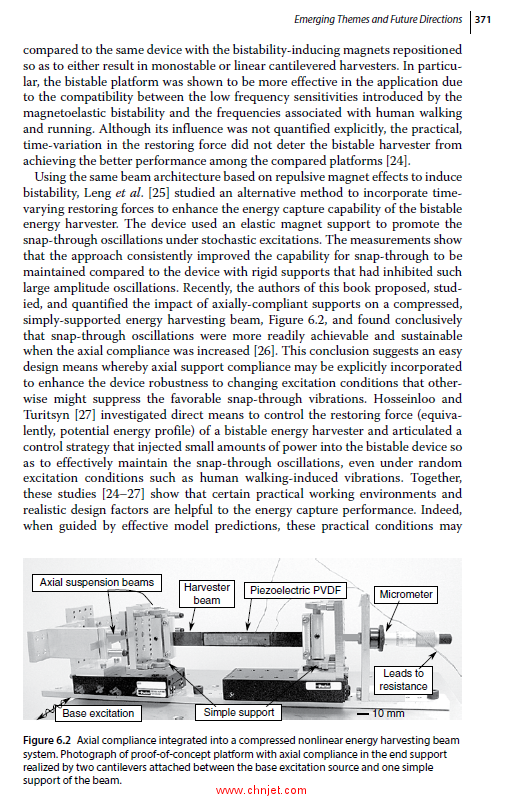马上注册,结交更多好友,享用更多功能,让你轻松玩转社区。
您需要 登录 才可以下载或查看,没有账号?立即注册


x
《Harnessing Bistable Structural Dynamics: For Vibration Control, Energy Harvesting and Sensing》
利用双稳态结构动力学:振动控制、能量收集和传感
作者:
Ryan L. Harne
The Ohio State University
Columbus, Ohio, USA
K.W. Wang
University of Michigan
Ann Arbor, Michigan, USA
出版社:Wiley
出版时间:2017年
《Harnessing Bistable Structural Dynamics: For Vibration Control, Energy Harvesting and Sensing》

《Harnessing Bistable Structural Dynamics: For Vibration Control, Energy Harvesting and Sensing》

《Harnessing Bistable Structural Dynamics: For Vibration Control, Energy Harvesting and Sensing》

《Harnessing Bistable Structural Dynamics: For Vibration Control, Energy Harvesting and Sensing》

目录
Preface xi
1 Background and Introduction 1
1.1 Examples of Bistable Structures and Systems 1
1.2 Characteristics of Bistable Structural Dynamics 6
1.2.1 Coexistence of Single‐periodic, Steady‐state Responses 8
1.2.2 Sensitivity to Initial Conditions 14
1.2.3 Aperiodic or Chaotic Oscillations 15
1.2.4 Excitation Level Dependence 16
1.2.5 Stochastic Resonance 21
1.2.6 Harmonic Energy Diffusion 22
1.3 The Exploitation of Bistable Structural Dynamics 24
1.3.1 Vibration Control 24
1.3.2 Vibration Energy Harvesting 27
1.3.3 Sensing and Detection 30
1.4 Outline of This Book 33
References 34
2 Mathematical Modeling and Analysis of Bistable Structural
Dynamics 39
2.1 A Linear Oscillator 39
2.1.1 Free Response 39
2.1.2 Base‐excited Response 44
2.2 Stability 46
2.3 A Monostable Nonlinear Oscillator 48
2.4 A Bistable Oscillator 50
2.4.1 Free Response and Stability 50
2.4.2 Base‐excited Response 54
2.5 Analytical Methods for Steady‐state Dynamics 57
2.5.1 Small Oscillations 58
2.5.2 Large Oscillations 62
2.6 Bifurcations of Bistable Systems 67
2.7 Multiple Degrees‐of‐Freedom Systems 69
2.8 An Electromechanical Bistable System 70
2.9 Summary 71
References 72
Contents
vi Contents
3 Vibration Control 75
3.1 Topic Review 75
3.1.1 Damping 77
3.1.2 Isolation 81
3.1.3 Absorption 83
3.1.4 Summary 86
3.2 High and Adaptable Damping Using Bistable Snap‐through
Dynamics 86
3.2.1 Model Formulation of the Bistable Device 87
3.2.2 A Metric for Energy Dissipation Capacity 89
3.2.3 Numerical Analysis of the Base‐excited Response 89
3.2.4 Energy Dissipation Features of the Dynamic Types 90
3.2.5 Influences Due to Change in Frequency and Initial Conditions 93
3.2.6 Experimental Studies 96
3.2.7 Summary 100
3.3 Isolating Structures Under Large Amplitude Excitations Through
Activation of Low Amplitude Interwell Dynamics: Criteria
for Excitation‐induced Stability 100
3.3.1 Governing Equation Formulation of the Bistable Oscillator 101
3.3.2 Stability of the Analytically Predicted Interwell Dynamics 102
3.3.3 Validation of the Stability Criteria Using Numerical Simulations 105
3.3.4 Experimental Validation of the Stability Criteria 109
3.3.5 Summary 115
3.4 Exploiting Excitation‐induced Stability for Dual‐stage Vibration
Isolation 115
3.4.1 Governing Equation Formulation of a Bistable Dual‐stage
Vibration Isolator 116
3.4.2 Analytical Solution of the Governing Equations 118
3.4.3 Examining the Stability of Analytical Predictions 119
3.4.4 Comparison of Isolator Performance with a Counterpart
Linear Design 119
3.4.5 Explanation of the Valley Response 122
3.4.6 Investigating the Design Parameter Influences 123
3.4.7 Influence of Initial Conditions 126
3.4.8 Prototype Investigations: Numerical and Experimental
Validation 131
3.4.9 Summary 136
3.5 Dynamic Stabilization of a Vibration Suspension Platform Attached
to an Excited Host Structure 137
3.5.1 Model Formulation of the Bistable Suspension Coupled
to a Flexible Structure 138
3.5.2 Analytical Solution of the Governing Equations 140
3.5.3 Description of the Linear Suspension for Comparison 141
3.5.4 Analytical and Numerical Assessment of Key Suspension
Dynamics 142
3.5.5 Excitation Condition Influences 145
3.5.6 Experimental Suspension System Platform 148
Contents vii
3.5.7 Experimental and Analytical Comparisons of Isolation
Performance 148
3.5.8 Summary 154
3.6 Snap‐through Dynamics for Vibration Absorption 154
3.6.1 Model Formulation of a Bistable Vibration Absorber 155
3.6.2 Analytical Investigation of Force Cancellation Performance 159
3.6.3 Experimental Investigation of Force Cancellation Performance 164
3.6.4 Summary 172
References 173
4 Vibration Energy Harvesting 181
4.1 Topic Review 181
4.1.1 Experimental and Numerical Developments in Energy Harvesting
with Bistable Devices 183
4.1.2 Analytical Developments in Energy Harvesting with Bistable
Devices 189
4.1.3 Summary 191
4.2 Effective and Straightforward Design Guidelines for High
Performance Operations 191
4.2.1 Analytical Formulation of Bifurcations Associated with Achieving
Snap‐through 192
4.2.2 Experimental Validation of the Analytical Premise 196
4.2.3 Derivation of Criteria for Sustaining High Power Generation
Performance 198
4.2.4 Evaluation of the Criteria Accuracy 199
4.2.5 Summary 200
4.3 Understanding Superharmonic Energy Diffusion in Bistable
Energy Harvesters 201
4.3.1 Bistable Energy Harvester Modeling: Electromechanical
Governing Equations 202
4.3.2 Amplitude Response Equations 204
4.3.3 Selection of System Parameters for Investigation 207
4.3.4 Comparison to 1‐Term Harmonic Balance Solution 208
4.3.5 Effects of Varying Excitation Amplitude 210
4.3.6 Superharmonic Energy Harvesting Analysis 215
4.3.7 Experimentally Investigating the Contribution of Total Harvested
Energy by the Superharmonic Component 217
4.3.8 Summary 221
4.4 Optimal and Robust Energy Harvesting from Realistic Stochastic
Excitations Using the Dynamics of Structures Designed Near the
Elastic Stability Limit 222
4.4.1 Modeling of Nonlinear Energy Harvester Platform 223
4.4.2 Preliminary Remarks on Accuracy, Comparisons, and
Experimentation 227
4.4.3 Noise Bandwidth and Level Influences on Ideal Designs 229
4.4.4 Criticality of Design at the Elastic Stability Limit 232
4.4.5 Impact of Asymmetry on Energy Harvesting Performance 233
viii Contents
4.4.6 Summary 235
4.5 Amplifying the Snap‐through Dynamics of a Bistable Energy Harvester
Using an Appended Linear Oscillator 237
4.5.1 Coupled Energy Harvesting System Governing Equations 239
4.5.2 Analytical Formulation by the Harmonic Balance Method:
1‐Term Prediction 240
4.5.3 Analytical Formulation by the Harmonic Balance Method:
2‐Term Prediction 243
4.5.4 Computing the Fundamental and Superharmonic Average Power
and Power Density 246
4.5.5 Roles of the Auxiliary Linear Oscillator 247
4.5.6 Roles of the Superharmonic Dynamics in the Energy Harvesting
Performance 251
4.5.7 Experimental Investigations of the Multiharmonic Dynamics
Enhancement via the Auxiliary Linear Oscillator 255
4.5.8 Summary 260
4.6 A Linear Dynamic Magnifier Approach to Bistable Energy
Harvesting 261
4.6.1 Governing Equations for the Bistable Harvester with Linear
Dynamic Magnifier 262
4.6.2 Approximate Solution by the Method of Harmonic Balance 264
4.6.3 Analytical and Numerical Investigations on the Roles of the
Linear Dynamic Magnifier Stage 267
4.6.3.1 Effect of the Mass Ratio 267
4.6.3.2 Effect of the Frequency Ratio 271
4.6.3.3 Effect of the Electromechanical Coupling 272
4.6.4 Interpreting Frequency Response Characteristics
of the Coupled Energy Harvester System 275
4.6.5 Experimental Validations and Investigations 277
4.6.5.1 Effect of Bistable Harvester Electromechanical Coupling 278
4.6.5.2 Effect of Bistable Harvester Mass 279
4.6.6 Summary 280
References 282
5 Sensing and Detection 291
5.1 Topic Review 291
5.1.1 Bistable Microsystems 293
5.1.2 Bifurcation‐based Microsystem Applications 298
5.1.3 Summary 300
5.2 Detecting Changes in Structures by Harnessing the Dynamics
of Bistable Circuits 301
5.2.1 Bifurcation‐based Sensing Platform Based on Bistable Circuitry 302
5.2.2 Bistable Circuit Model Formulation and Validation 305
5.2.3 Investigation of Operational Parameters Suited for Bifurcation‐based
Sensing 308
5.2.4 Experimental Study of the Proposed Bifurcation‐based Sensing
Approach 309
Contents ix
5.2.5 Summary 311
5.3 Improving Damage Identification Robustness to Noise and Damping
Using an Integrated Bistable and Adaptive Piezoelectric Circuit 312
5.3.1 An Integrated Bistable and Adaptive Piezoelectric Circuitry for
Bifurcation‐based SHM 313
5.3.2 Overview of Damage Identification Using Integrated Adaptive
Piezoelectric Circuitry 316
5.3.3 Verification of Bifurcation‐based Detection of Frequency Shifts 318
5.3.4 Improving the Accuracy of BB Frequency Shift Detection Through
a Greater Number of Evaluations 321
5.3.5 Investigation of Noise Influences for a Mildly Damped Structure 323
5.3.6 Investigation of Noise Influences for a More Highly Damped
Structure 325
5.3.7 Summary 327
5.4 Passive Microscale Mass Detection and Progressive Quantification by
Exploiting the Bifurcations and Resonant Dynamics of a Two DOF
Bistable Sensor 327
5.4.1 Sensor Architecture and Operational Principle Overview 330
5.4.2 Experimental Proof‐of‐concept Sensor Architecture 334
5.4.3 Model Formulation of the Sensor Architecture 336
5.4.4 Experimental Validation of the Model Formulation and Numerical
Examinations of System Operation 337
5.4.5 Examination of Passive Quantification of Mass Adsorption via
Sequential Activation of Bifurcations 340
5.4.6 Experimental Comparison of Bifurcation Triggering and
Fundamental Mode Natural Frequency Reduction as Consistent
Detection Metrics 342
5.4.7 Stochastic Modeling and Noise Sensitivities 344
5.4.8 Operational Parameter Influences for Passive Sensing Strategy 349
5.4.9 Sensor Embodiments and Fabrication Strategies 354
5.4.10 Summary 355
References 355
6 Emerging Themes and Future Directions 365
6.1 Emerging Themes 365
6.1.1 Vibration Control 365
6.1.2 Vibration Energy Harvesting 369
6.1.3 Sensing and Detection 372
6.2 Challenges and Future Outlooks 377
6.2.1 Theoretical Characterization of the Emerging Bistable and Multistable
Structural/Material System Concepts 377
6.2.2 Application Relevance and Readiness 379
References 381
Index 387
专业书籍
下载地址:(回复后可见)
| ![]()
![]()